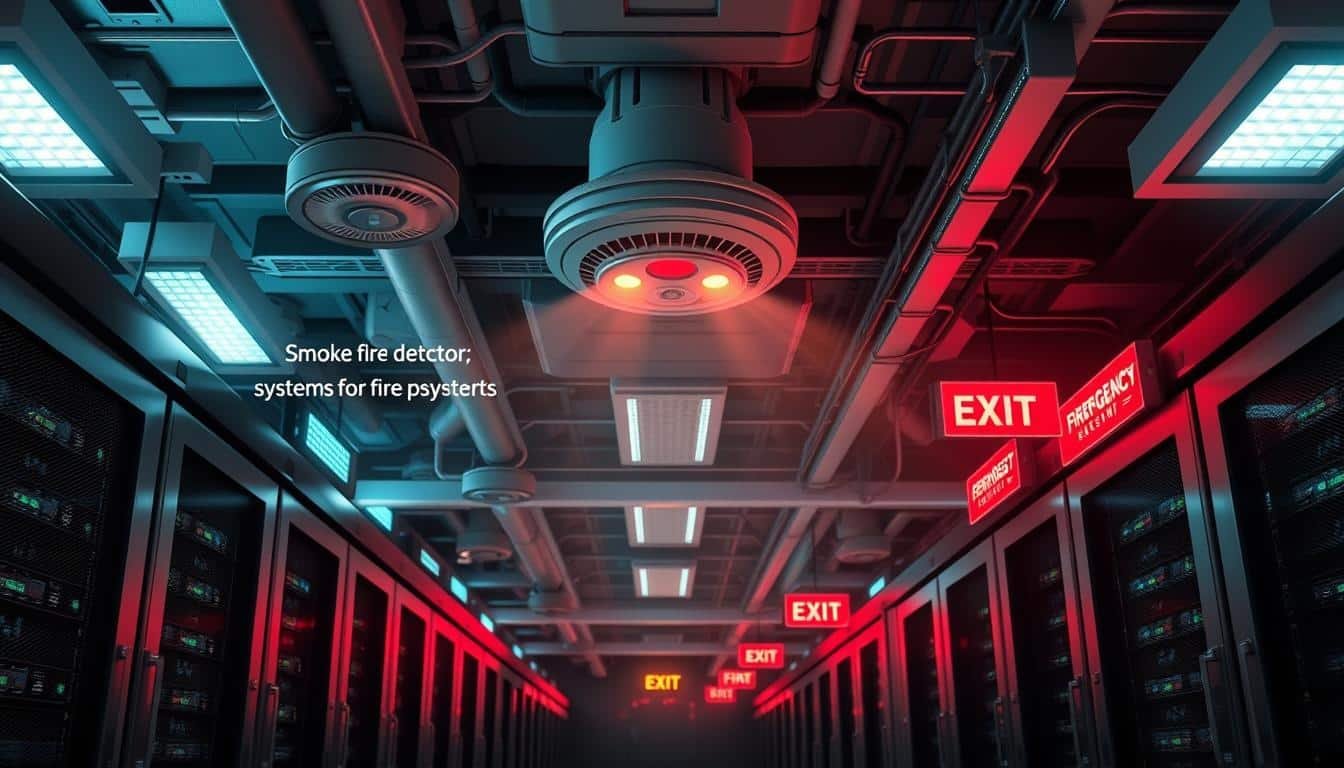In today’s fast world, data is key for businesses. Keeping your data center safe and reliable is crucial. As an IT pro, you know how important fire protection is for your IT setup. The IDCW has created detailed guidelines for fire safety in data centers. These help make sure your place is ready for any emergency.
Key Takeaways
- Discover the essential components of fire detection and suppression systems for data centers
- Understand the impact of fire incidents on business continuity and learn strategies to minimize risk
- Explore the latest industry trends and best practices for effective fire emergency response planning
- Familiarize yourself with the maintenance and compliance requirements for data center fire safety systems
- Ensure your data center is equipped to handle fire emergencies and protect your critical IT assets
Understanding the Importance of Data Center Fire Safety
Fire safety is key for data centers. These places hold vital IT systems that keep businesses running. Good fire prevention strategies and fire safety compliance are crucial to protect your data center from fire damage.
The Critical Role of Fire Protection in Data Centers
Data centers are built to be secure and controlled. But, they still face a fire risk assessment. With valuable electronics and flammable materials, fire protection systems are a must.
Impact of Fire Incidents on Business Continuity
A fire in a data center can hurt your business a lot. It can cause downtime, data loss, and even stop operations completely. Getting back to normal after a fire is hard and costly.
Current Industry Statistics and Trends
Data center fires have been going up in recent years. They’re often caused by electrical issues, human mistakes, and natural disasters. It’s important to have strong fire safety compliance to reduce these risks.
| Metric | 2020 | 2021 | 2022 |
|---|---|---|---|
| Number of Data Center Fires | 45 | 52 | 61 |
| Average Downtime per Incident (hours) | 12 | 16 | 18 |
| Estimated Financial Impact (in millions) | $8.2 | $10.4 | $12.9 |
“Investing in comprehensive fire protection systems is not just a matter of compliance, but a strategic imperative for safeguarding your data center and ensuring the continuity of your business operations.”
IDCW Guidelines for Data Center Fire Safety Systems
Keeping your data center safe is crucial. The IDCW guidelines offer a detailed plan to do this. They cover the key steps to protect your data center and keep it running smoothly.
The IDCW focuses on three main areas: fire detection, fire suppression, and fire prevention. Following these guidelines boosts your data center’s fire safety. It also protects your fire protection equipment.
Comprehensive Fire Detection Strategies
Early fire detection is vital, as it can prevent big problems. The guidelines suggest using advanced fire detection tools like smoke detectors and heat sensors. These tools quickly spot fires, allowing for a quick response.
Robust Fire Suppression Measures
When a fire happens, the IDCW has clear steps for fire suppression. It recommends using automated fire systems like FM-200. These systems put out fires fast without harming your equipment.
Proactive Fire Prevention Strategies
The IDCW also stresses the importance of fire prevention. It suggests using fireproof materials and following strict safety rules. This helps avoid fires from starting in the first place.
Following the IDCW guidelines ensures your data center is safe. It helps protect your assets and keeps your business running smoothly. Investing in fire safety is key to your data center’s future.
Essential Components of Fire Detection Systems
In the world of data center fire safety, fire detection systems are key. They quickly spot and alert people to fire dangers. Knowing what makes up these systems helps protect data centers better.
Early Warning Detection Technologies
Advanced fire detection tech is crucial for early warnings and less damage. Tools like aspirating smoke detectors and linear heat detection systems spot smoke or heat fast. They send out alerts right away, helping teams respond quickly.
Smoke Detection and Heat Sensors
Smoke detectors and heat sensors are the heart of fire detection systems. They watch over the data center, looking for fire or high temperatures. By placing these sensors everywhere, data centers can catch even the smallest fire signs early.
Integration with Building Management Systems
Fire detection systems work best when they’re part of the building’s management. Connecting them with building control systems makes the whole system better. This setup lets operators watch everything from one place, making safety measures work together better.
| Fire Detection Technology | Advantages | Compatibility with Fire Protection Equipment |
|---|---|---|
| Aspirating Smoke Detectors | Early warning, High sensitivity | Fire sprinklers, Gaseous suppression systems |
| Linear Heat Detection Systems | Rapid response, Monitoring of large areas | Fire extinguishers, Foam suppression systems |
| Integrated Building Management Systems | Centralized control, Enhanced coordination | Emergency lighting, Alarm notification devices |
Understanding fire detection systems helps data center operators protect their space. By using early warning tech, advanced sensors, and building management systems, they create a strong fire safety plan. This plan keeps operations running smoothly and data safe.
Fire Suppression Methods and Technologies
In data centers, picking the right fire suppression methods is key. These systems protect your data and keep your business running if a fire happens. Let’s look at the different fire suppression options and what to consider.
Clean agents like FM-200 or Novec 1230 are common in data centers. They work well to put out fires without harming your electronics. These agents turn into gas and quickly stop flames and fire spread.
Water mist systems are also popular. They use tiny water droplets to cool down and stop fires. This method is good for data centers because it protects without causing too much water damage.
Inert gas systems, like nitrogen or argon, are used too. They work by taking away oxygen, so the fire can’t keep burning. These systems are clean and efficient, without causing extra damage.
Choosing the right fire suppression method for your data center is important. You need to think about your facility’s needs, the environment, and how it will affect your operations. Talking to fire protection experts can help you make the best choice and use the most effective fire prevention strategies.
| Fire Suppression Agent | Key Advantages | Potential Limitations |
|---|---|---|
| Clean Agents (FM-200, Novec 1230) |
|
|
| Water Mist Systems |
|
|
| Inert Gas Systems |
|
|
Knowing the good and bad of these data center fire suppression technologies helps you make a smart choice. The right choice fits your fire prevention strategies and fire protection equipment needs. It keeps your data center safe and your operations running smoothly.
Implementing Effective Fire Emergency Response Plans
Data centers face high risks from fires. These incidents can stop business and cause huge damage. So, it’s key for data centers to have strong fire plans. They need to train staff well and make sure evacuation plans work.
Staff Training and Emergency Protocols
Fire safety training is a must for data center workers. They need to know how to prevent fires and what to do in an emergency. This training helps them stay calm and get out safely.
Evacuation Procedures and Safety Zones
Data centers need clear evacuation plans. These plans should be practiced in drills. They should show the best ways to get to safe areas.
It’s important to keep emergency exits clear and well-lit. This makes sure everyone can get out quickly and safely.
Communication During Fire Emergencies
Good communication is key in a fire. Data centers need plans for alerting people and keeping them updated. Testing these plans often is crucial.
By focusing on fire plans, training, and clear communication, data centers can keep their people and data safe. Staying ready for fires is not just good practice. It’s essential for keeping business running and data safe.
| Key Components of Fire Emergency Response Plans | Best Practices |
|---|---|
| Staff Training and Emergency Protocols |
|
| Evacuation Procedures and Safety Zones |
|
| Communication During Fire Emergencies |
|
“Effective fire emergency response planning is not just a best practice, but a critical imperative for maintaining business continuity and ensuring the safety of mission-critical data infrastructure.”
Maintenance and Compliance Requirements
Keeping your data center’s fire safety systems working well is key. You need to follow regular check-ups, test everything thoroughly, and keep detailed records. This shows you meet all the rules and standards.
Doing fire risk assessments often is crucial. It helps you see and tackle new risks in your data center. This way, you can keep your business running smoothly and meet legal fire safety rules.
Working with fire protection experts is a smart move. They can guide you on the best fire safety tech, help with audits, and make sure your systems are up to date. This helps you stay on top of changing rules and risks.
FAQ
What are the key components of a comprehensive data center fire safety system?
A good data center fire safety system has early warning detectors like smoke and heat sensors. It also has a fire alarm system to monitor these. Fire suppression methods, such as clean agents or water mist, are chosen based on the data center’s needs.
It’s also important to have a plan for emergencies, train staff, and keep equipment in top shape. This ensures your data center is safe.
How do IDCW guidelines help ensure data center fire safety?
IDCW guidelines offer detailed advice on fire safety in data centers. They cover fire detection, suppression, prevention, and following industry standards. Following these guidelines helps make sure your data center has the right fire protection systems and plans.
This reduces the risk of fires and keeps your IT infrastructure safe.
What are the key fire prevention strategies for data centers?
Key fire prevention strategies include regular risk assessments and strong fire detection systems. Using the right fire suppression technologies and following industry rules are also important.
Having a good emergency plan, training staff, and clear communication are key to managing fire risks. This helps keep your business running smoothly even in emergencies.
How can data centers ensure compliance with fire safety regulations?
Ensuring fire safety regulations are followed is crucial for data centers. This means following industry standards, like those from IDCW, and doing fire risk assessments regularly. Keeping fire protection equipment in good shape and documenting all checks is also important.
Staying updated with fire safety rules and best practices is essential. Working with fire safety experts and regulatory bodies helps keep your data center safe and compliant.
What are the key considerations for effective fire emergency response planning in data centers?
Good fire emergency planning in data centers includes several key points. Staff must be trained on fire safety and know how to evacuate. There should be clear communication channels during emergencies.
Regular drills and updates to the plan are vital. This ensures the plan works well and staff is ready for emergencies.



